The global cities most ready and in need of self-driving cars
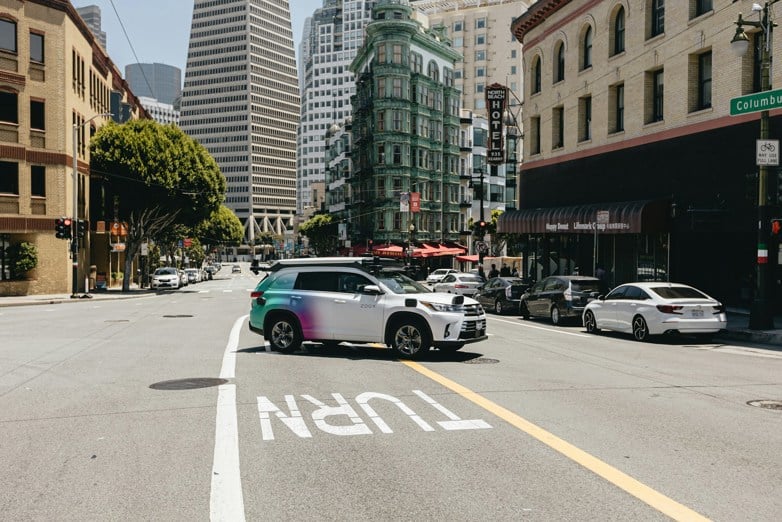
Autonomous vehicles (AVs) are the automotive industry's biggest upcomers, and could soon be the mainstream reality around the world. China’s WeRide and the USA’s Waymo are already setting themselves as the leaders in the industry, with robotaxis in operational use in both countries.
As the price of public transport rises across the globe, for example, in Europe fares have risen 15% per km since 2019[1], and countries in Asia, such as Singapore, have reported 6% hikes[2]. AVs offer a sustainable alternative, improving the enjoyment of journeys, reducing fuel prices and making travel smoother and less dangerous.
The global AV market is worth $273.75 billion in 2025, a figure which is expected to grow to $4,450.34 billion by 2034[3] as these cars are set to revolutionise the auto industry as we know it.
However, while AVs’ value is expanding rapidly across global markets, the question is, are cities ready for this unprecedented innovation, and what factors prove their readiness?
We’ve analysed factors from road traffic death rate, mean working hours per week, travel time per 10km, and the price of taxis per 10km to reveal the cities around the world most in need of AVs. We have also found the cities that are most ready for the change by analysing mobile and broadband upload and download speeds.
- San Francisco is the city most in need of autonomous vehicles in the world, with the highest demand for driverless jobs (247.41 per capita)
- Dublin has the highest travel time per 10km in the world, with 33 minutes, highlighting their need for smoother journeys
- Housing affordability is suffering the most in Beijing; therefore, residents need accessibility to move away from cities, and AVs could reduce reliance on limited public transport
- Fukuoka is home to the most expensive taxis, with an average cost of £36.92 for a 10km journey - AVs have lower standard fares
- Dubai is the city most ready for the introduction of autonomous vehicles, scoring 78.51 out of 100, thanks to 503.38Mbps mobile download speed
Some cities around the world have already welcomed AVs in the form of robotaxis. The most well-known example is Waymo in the USA, which is currently available to consumers in Phoenix, San Francisco, Los Angeles, Austin, Atlanta, and Silicon Valley[4].
In China, WeRide operates in Guangzhou, Beijing, Nanjing, Suzhou, Dongguan, Zhengzhou, and Erdos[5]. Despite hosting these services, some of these cities still rank among the most in need of AVs due to expensive public transport and high demand for jobs. In other words, while AVs are already present, their services remain in high demand.
We’ve analysed the data to reveal exactly which cities around the world are the most in need of autonomous vehicles, and how they could improve these destinations.
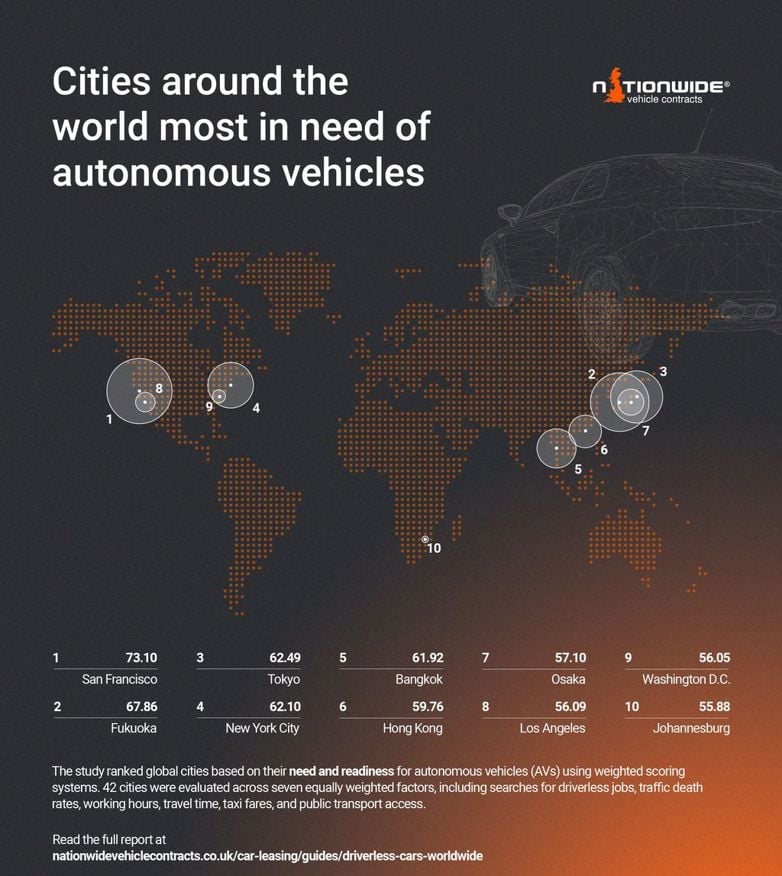
San Francisco, USA, has been named the city most in need of autonomous vehicles in the world, with the highest index score of 73.10 out of 100.
The city is currently home to 800 operating robotaxis from software company Waymo[5], and their appearance is driving demand for ‘driverless jobs’. The highest searches per capita for ‘driverless jobs’ (247.41) in the world come from San Francisco, indicating residents are keen to expand automotive careers into the AV industry in the form of incident response and software development.
Despite the initial rollout, the 827,526[6] San Francisco locals outweigh the number of available AVs and still face chaotic scenes on the roads, with a 14.20 road traffic death rate, over 5x the rate of Fukuoka and Tokyo.
With the demand for jobs up and the roads in a dangerous state, a further AV rollout could provide a helpful solution to both the economy, by supplying more jobs and society by improving road safety.
Fukuoka, Japan, home to almost 5.5 million people [7], ranks as the second-most in need of autonomous vehicles worldwide, and it is not yet home to any.
The city faces the highest taxi fares in the world, with a 10km journey costing £36.92. On top of that, the same trip takes an average of 31 minutes, nearly double the time it takes in Los Angeles, a city notorious for traffic.
These figures highlight the severe congestion on Fukuoka’s roads. Autonomous vehicles could provide a lasting fix, reducing wait times, cutting transport costs, and helping to ease the city’s traffic chaos.
Another Japanese city in the top three most in need of AVs is Tokyo, where Waymo LLC is currently trialling autonomous vehicles on public roads[8].
Average journeys are slightly shorter than in Fukuoka (27 minutes) and taxi fares are lower (£27.55 per 10 km), but with 37 million residents[9] and 2.5 million daily commuters[10], the city faces significant pressures.
Only 12% of journeys made are by private car, one of the lowest rates of car use in the world[11], as the majority travel by public transport and face high parking prices.
But with so many people commuting daily, autonomous vehicles could transform Tokyo into a smoother, more connected metropolis, cutting long wait times, enabling seamless direct journeys, and helping the city flow more efficiently.
Sitting in traffic is a common experience for drivers, and unfortunately, due to growing populations, something which is impossible to avoid.
But in some cities around the world, the experience is far worse, and these are the cities where a 10km journey would take the longest.
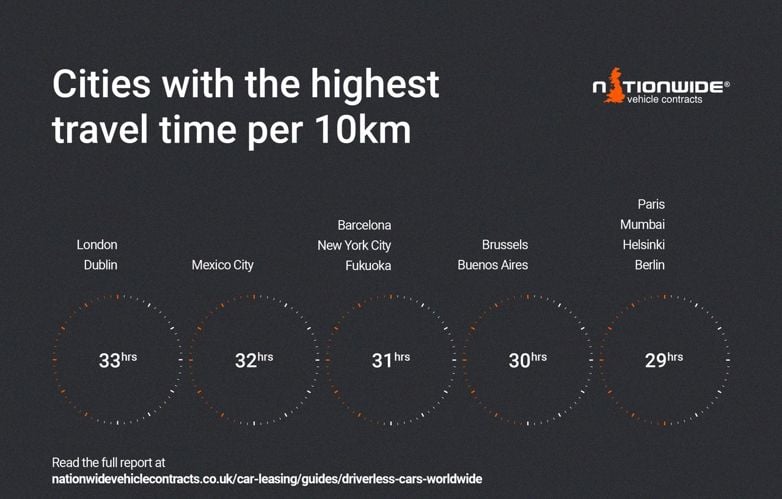
Longer hours on the road can quickly lead to tiredness behind the wheel, which can ultimately cause more accidents and crashes. AVs provide the solution to this, allowing passengers to fully switch off and relax during journeys.
Dublin and London have been found to have the longest journey times in the world, with a 10km journey taking a shocking 33 minutes. For comparison, the global average of a 10km is 7 minutes and 48 seconds[12].
Dublin is known for its congestion and difficult roads, and was previously named one of the hardest cities to navigate in the world.
As for London, the UK’s capital is flooded with taxis, buses, and commuters and is further confused by restriction zones and one-way streets, making the 10km journey not just long, but stressful.
Mexico City, also known as the hardest city to navigate in the world, is another city where it takes drivers far too long to travel just 10km.
With an estimated 55.2 million vehicles on the road[13], driving here can mean unsuitably long wait times.
In Mexico City, this journey takes 32 minutes, beating out other incredibly busy cities such as New York City, Mumbai and Paris.
The housing market is troublesome in many countries around the world, as salaries struggle to keep up with property prices. But which cities are the most expensive when it comes to Property Price to Income Ratio, and how could AVs help tackle the problem?
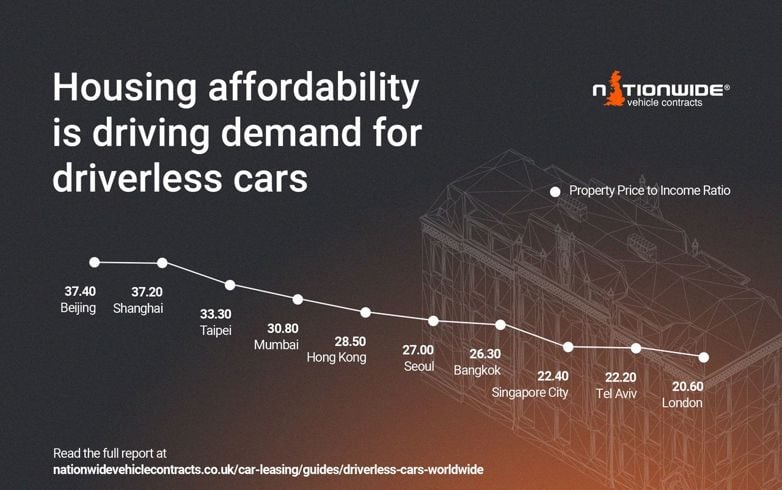
If cities were adapted to autonomous vehicle use, the reliance on proximity to major cities would be reduced massively, allowing people to move out of city centres and reducing traffic on city roads. Autonomous vehicles make commuting from these more distant places easier (less stressful and time-consuming), and people can find more affordable housing.
The average price per sqm for new-build homes in Beijing, China is £4,797.28[14], meaning a typical 88–98 sqm apartment could cost around £470,000[15]. With an average annual wage of just £11,753.84[16], purchasing a home in the city is a huge challenge for most residents.
AVs in this city would relieve residents from the pressure of saving for a property in the city, and would have the ability to move further out. This way, they could benefit from city centre salaries but enjoy the lower-priced properties outside of the city.
Shanghai has a Property Price to Income Ratio of 37.20 due to the average property price per square meter in Shanghai being £5,995.48[17]. With the average sqm at 88-98[18], it equates to £527.6k-£587.6k for the average property.
As for Taiwan, the average 3-bed property costs £490,556.80[19], but the average yearly wage for the private sector works out at £15,781.76[20], making the house prices over 31x the wage, and naturally, house buyers will only be saving a small portion of their wage each year.
The same can be said for these two cities; distancing themselves from the city centre would allow residents to find much more affordable housing and ease commutes into the city.
Autonomous vehicles promise to make everyday life easier, from reducing traffic congestion and saving time to even reshaping the housing market. But the benefits extend beyond smoother commutes. As these vehicles move closer to reality, people aren’t just thinking about improved driving; many are also seeing them as a chance to rethink their careers.
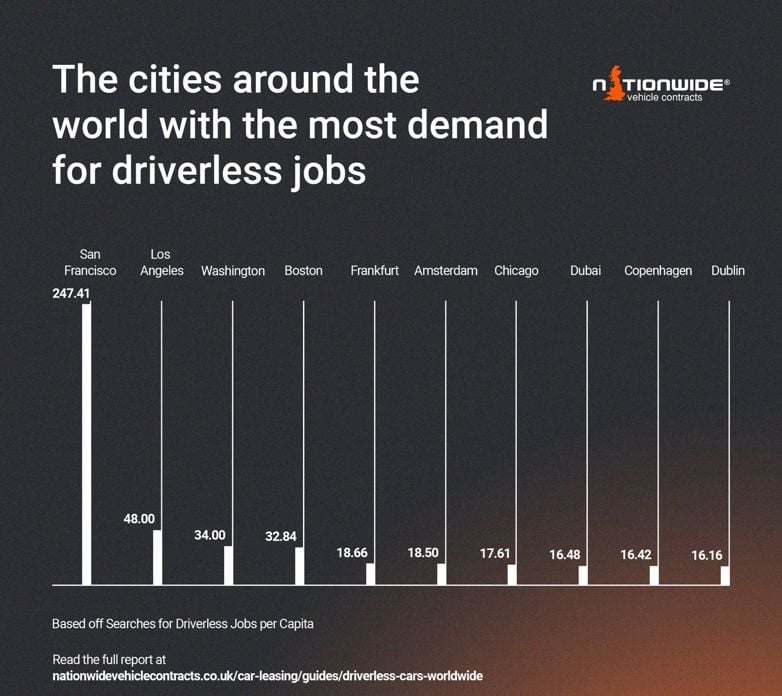
Searches across the world are starting to rise now that autonomous vehicles inch closer to reality, but US cities in particular are driving the surge in demand for searches per capita for ‘driverless jobs’.
San Francisco is already home to one form, driverless taxis, and the city is leading the way in the industry. Brand Waymo currently operates 24/7 taxis in the city, which users can book from a mobile app[4]. That’s why it’s no surprise the demand for jobs in the sector is surging, with 247.41 searches per capita, 5x the amount of second-place Los Angeles.
Two other major cities in the U.S. are also seeing a rise in searches for driverless jobs per capita: Los Angeles with 48.00 and Washington, D.C. with 34.00.
In L.A., Waymo have been operating its driverless taxis since late 2024 [4], and although, of course, there is no one at the wheel, they are creating jobs in terms of incident responses, engineering and vehicle maintenance.
As for Washington D.C., Waymo are not currently operating but plans to launch in 2026 [4].
As private car ownership becomes less common in major cities, with more people than ever relying on public transport as their main mode of transportation, some cities in particular are seeing the prices of taxis soaring, with some costing an average of £36.92 for a single 10km journey.
But how can AVs help to decrease this cost?
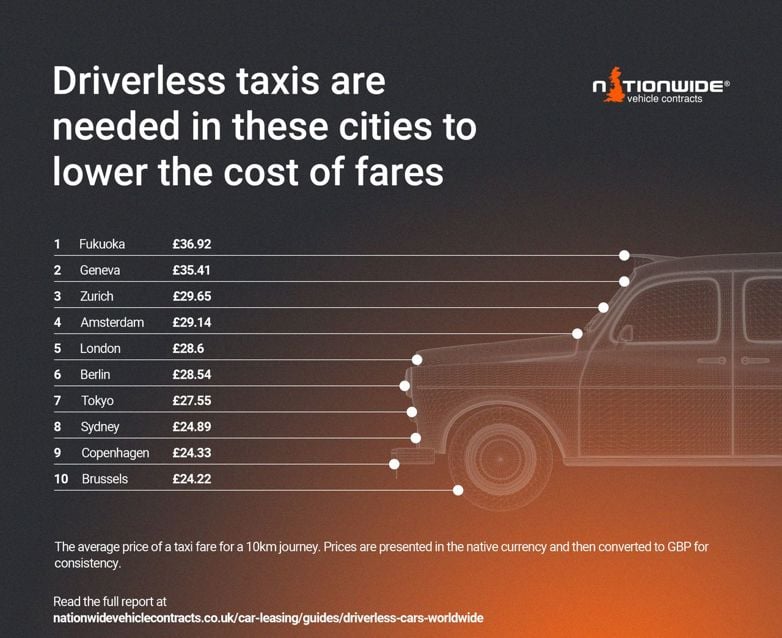
Fukuoka, Japan, claims the title for the highest taxi fare per 10km in the world, priced at £36.92. In Japan, the average for the same journey would typically cost £17.73[21], meaning this city is coming in almost £20 higher.
For comparison, the average robotaxi journey in China costs £0.26p per mile[22], that’s £1.62 for a 10km ride. If these were to be implemented in Fukuoka, taxi users could expect to travel for almost 23x less, saving both money and time if to switch to AVs.
In Switzerland, public transport is known to be expensive but is made affordable by options such as the Half Fare Card, giving a 50% discount on all journeys made by bus, train or boat[23]. However, when it comes to taxis, fares are some of the most expensive in the world.
In Geneva, a 10km journey costs £35.41 and in Zurich £29.65, beating out cities known for being expensive, such as London and Tokyo.
In order for autonomous vehicles to thrive in cities, they need the most important thing to allow them to run smoothly: technology. Not only technology, but reliable access to broadband, Wi-Fi and 5G, due to their real-time communication to fuel V2X (vehicle-to-everything), sensor and map data processing and real-time navigation and traffic updates.
That's why we’ve crunched the numbers of cities around the world to see which have the best Wi-Fi access, to see where AVs could take off comfortably.
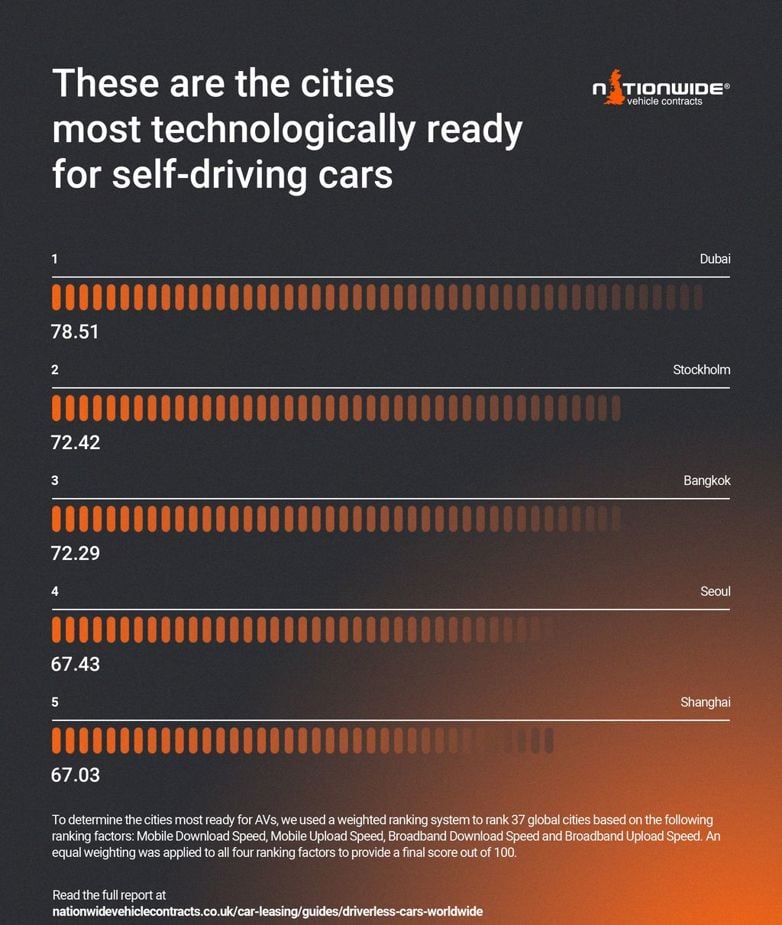
The UAE city of Dubai received a score of 78.51 for mobile and broadband upload and download speeds. The city is known for its technological advancements and is expected to welcome its first version of operational AVs by the first quarter of 2026[24].
Stockholm, Sweden, also stands well prepared for the arrival of AVs with a score of 72.42. The Swedish authorities decided to decline Tesla’s request to test robotaxis in June 2025[25], and currently have no further plans to introduce them. But when they are ready, the city will be more than capable of fuelling their real-time connectivity.
Bangkok, Thailand, claimed third place (72.29) for its technological connections. The Thai city is known globally for its manic roads, but this city could be the perfect place to launch AVs thanks to strong wireless access.
Two companies have already done so, Waymo and Baidu Apollo. Two more are also looking to begin trial, Cruise and AutoX[26], highlighting that many are taking advantage of the city's need for accessibility and great connections.
-
As technology continues to evolve at an incredible pace, it’s natural to feel some hesitation when adapting to the latest innovations. Yet with the UK positioned as a leader in this progress, we’re committed to staying at the forefront, ensuring our customers benefit from the very best in car leasing.
At Nationwide Vehicle Contracts, we promise that no matter how the market changes, our customers will always enjoy access to the newest vehicle technology through our leasing options, delivered in the safest, most reliable condition for a truly enjoyable driving experience.
Methodology
Nationwide Vehicle Contracts looked at various factors to create a ranking to identify which cities across the world are the most in need and ready for driverless cars.
We analysed various data metrics to conclude which cities were most in need of driverless cars including Searches for Driverless Jobs per Capita, Road Traffic Death Rate, Mean Working Hours per Week, Travel Time per 10km (minutes), % of Population Aged 65+, Price of Taxi Fare for 10km journey (£), % with Convenient Access to Public Transport.
For the cities that are the most ready, we analysed Mobile Download Speed, Mobile Upload Speed, Broadband Download Speed and Broadband Upload Speed.
- Searches for Driverless Jobs per Capita- Google Trends/Keywordtool.io
- Road Traffic Death Rate- World Health Organisation
- Travel Time per 10km (minutes)- TomTom Index
- % of Population Aged 65+- Statista
- Price of Taxi Fare for 10km journey (£)- Numbeo
- % with Convenient Access to Public Transport- OWID
- Housing Affordability- Numbeo
- Mobile Download/Upload Speed and Broadband Download/Upload Speed- Speedtest
- Global Power City Index - GPCI
Sources
- [1] EU Public Transport fares- CheckMyBus
- [2] Singapore Public Transport Fares- Public Transport Council (PTC)
- [3] AV Global Market Value- Precedence Research
- [4] Waymo operating cities- Waymo
- [5] WeRide operating cities- WeRide
- [6] San Francisco population- Data Commons
- [7] Fukuoka population- World Population Review
- [8] Tokyo Waymo rollout- The Robot Report
- [9] Tokyo population- World Population Review
- [10] Tokyo commuting population- EF
- [11] Tokyo private car usage- Deloitte
- [12] Number of vehicles in Mexico City- ITF
- [13] Average 10km journey- Calculat.io
- [14] Beijing House Price- Global Property Guide
- [15] Beijing House sqm- Colliers
- [16] Beijing average wage- FDI China
- [17] Shanghai House Price- Global Property Guide
- [18] Shanghai House sqm- Colliers
- [19] Average Taiwan house price- Global Property Guide
- [20] Average Taiwan wage- ZipRecruiter
- [21] Japan Average Taxi Fare- Japan Guide
- [22] Average robotaxi price China- Coin Central
- [23] Switzerland half share card- Swiss Railways
- [24] Dubai robotaxi launch date- Dubai’s Roads and Transport Authority (RTA)
- [25] Stockholm Tesla ban- Tesla Accessories
- [26] Bangkok robotaxi rollout- Mobility Foresights
Guide Information
Originally published: 30th September 2025
